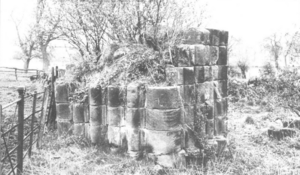Dieulacres Abbey facts for kids
Dieulacres Abbey was a Cistercian monastery. It was first started by Ranulf, Earl of Chester in a place called Poulton in Cheshire. The abbey later moved to its current location at Abbey Green, near Leek, Staffordshire, in 1214. One reason for this move might have been attacks by the Welsh people at the old site.
Contents
The Abbey's Story
The name Dieulacres means 'may God increase it.' This name comes from something Ranulf's wife supposedly said. Ranulf told her about a dream where his grandfather, who had passed away, asked him to move the abbey from Poulton.
After Ranulf died, his heart was buried inside the abbey. His body was buried somewhere else. This might seem strange today, but it was a common practice during the medieval period.
Early Challenges
During the 1200s, Dieulacres Abbey had many disagreements with other monasteries nearby. These included Croxden Abbey and Trentham Priory. The arguments were mostly about who owned land, especially grazing areas for animals, and who could collect taxes (called tithes). Luckily, these problems were usually solved without big fights, which sometimes happened in other places.
Dieulacres Abbey was the second-largest landowner among monasteries in the county. Only Burton-on-Trent Abbey owned more land.
In the 1300s, the abbey faced more difficulties. In 1339, the King took control of the abbey. This happened because people claimed the abbey had gained land against a law called the Statute of Mortmain. This law was about how churches could own land. However, the abbot quickly proved that the abbey had done nothing wrong, and it was returned to them.
Problems and Disagreements
Later in the 1300s, the King gave the abbey special protection. However, the monastery itself sometimes caused problems in the area. The abbot, who was the head of the abbey, had a group of armed guards.
In 1379, a royal investigation found that the Abbot of Dieulacres used these armed men to control the area. They were accused of causing trouble for people in Staffordshire. They would wait for people, attack them, and force others to leave their homes.
In 1380, the abbot himself was arrested and put in prison. This was after an incident where one of his men caused harm to a person named John de Wharton. Surprisingly, the abbot was soon forgiven and set free.
Abbey Troubles
In the years that followed, some members of the abbey were accused of stealing. People also criticized the abbot for seeming to protect them. There were many lawsuits, which are legal battles, involving the abbey.
In 1517, Abbot William Albion and eight monks were accused of being involved in a large public disturbance in Leek. This happened when they tried to stop the arrest of an abbey official. Even the abbot was seen using a bow during the event! Because of these actions, he was removed from his position, and so was the abbot who came after him.
The last abbot, Thomas Whitney, was known for treating the abbey's tenants unfairly. He was also possibly involved in dishonest dealings.
The End of the Abbey
Dieulacres Abbey was officially closed in 1538. This was part of a bigger event called the Dissolution of the Monasteries, when King Henry VIII closed many monasteries in England. Most of the abbey's belongings were sold off just a few days after it closed. The land was then given to a person named Sir Ralph Bagnall.
Michael J. Fisher, who wrote about Dieulacres, says that after Queen Elizabeth I became queen, the abbey land passed from the Bagnall family to the Rudyard family. It was probably the Rudyard family who built the current Abbey Farm in the early 1600s.
Since then, Dieulacres has been owned by many different families. None of them stayed there for a very long time. It is said that at one point, the land was even used to pay off a large debt from gambling! Its history since 1538 seems to have been quite difficult.
What Remains Today
Today, the only parts of the original abbey that can still be seen above ground are the bases of two large pillars. These pillars were once part of the central tower where the church's arms crossed. A stone coffin can also be seen. Most of the other ruins were taken down before 1820. Much of the stone was used to build nearby farm buildings and other structures. Many carved stones from the abbey can still be found in these buildings.
Images for kids



